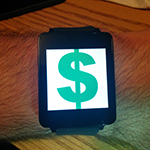Google's recently launched Android Wear platform had a bit of a rough weekend when it ran into an unexpected snag regarding paid apps – it couldn't install them. It turns out that the behavior could be traced to a Play Store security feature that was responsible for encrypting paid apps to make them more difficult to pirate; but in doing so, it had also made it impossible to extract and install any micro-apps contained within the apk. Tuesday night, Google responded to developers with an apology and a set of steps to reconfigure development projects to circumvent the installation issue.
To implement Google's proposed workaround, developers will have to make some simple one-time changes to the configuration of their projects and then endure a couple extra steps to manually package final versions for release. The change centers around relocating the micro-apk from the /assets folder to /res/raw, which makes it accessible to the Wear installer. It's a little more work, but it should be fairly painless as long as the steps are followed closely.
The blog post went on to explain that an update to Android Studio would be issued in the future to improve support for this configuration, which likely means there will also be an update to the New Project template to reduce confusion for developers in the future. Additionally, the documentation for Packaging Wearable Apps will be updated to reflect the project changes. (At the time of this post, the old version is still up.)
Providing a workaround won't break existing infrastructure and it's surely faster than issuing software updates to Google Play Services (GMS) or the Wear companion app. Unfortunately, it also means there will be some confusion among developers that are unaware of the fix when they publish their apps. If you come across a paid app that fails to install its Wear component, please be understanding and direct the developers to Google's blog post instead of leaving a negative 1-star review.
There's no point in sugarcoating it, this bug probably should have been found and fixed before launch. Still, we should give some credit to the Android Wear team for turning around a solution in just under 2 days. Fortunately, Android Wear spent its first several days in the hands of Google I/O attendees rather than launching directly to store shelves where end users wouldn't have been as understanding.
Source: Google Developers Blog via Android Developers Community (G+)
Thanks to Wayne Piekarski of Google for the quick heads-up!

